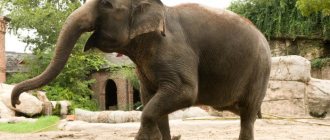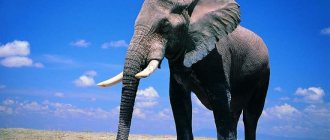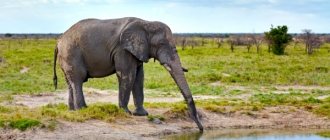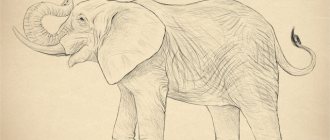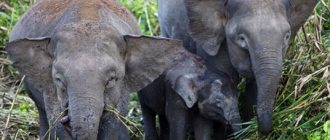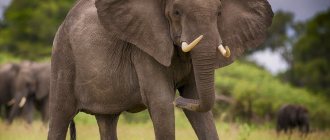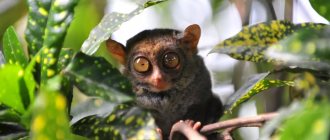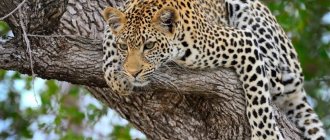The Indian elephant is a very large mammal. The genus Elephas originated on the African continent during the Pliocene period. Then the species began to spread across the continent. After this, animals began to appear in Asia. Indian elephants play a big role; they are considered sacred animals in India, they are symbols of wisdom. These animals regularly take part in ceremonies in religions such as Hinduism.
For example, albino elephants commonly carry statues of gods in Kerala. There they are practically the property of the temple. Representatives of the first religion believe in Ganesha, a god depicted as a man with an elephant’s head.
Engravings have been found that date back to the 3rd millennium BC. They were found in the Indus River Valley.
Types of Indian elephants
By origin, the Indian elephant belongs to the Asian subspecies. In addition to the Indian one, it includes the Sumatran subspecies, elephants of Sri Lanka and Borneo.
Sumatran elephant
The Indian elephant is more common. Now in Asia there are places where Indian elephants live, which tourists love so much. Animals there are often treated poorly. Perhaps people take advantage of elephants' excessive friendliness.
The height of the Indian elephant ranges from 2 to 3 meters, and the mammals weigh from 2 to 5 tons. They have 38 ribs. The length of the body with head can reach 600 – 650 centimeters.
Animal skin is thick and quite dry. It is usually gray or brown in color. Patches of depigmentation may occur. The long tail and trunk make it possible to move both accurately and directionally, as well as powerfully. Male animals have incisors, that is, tusks. Sexual dimorphism is expressed in that females are smaller and usually do not have tusks.
Elephant in Sri Lanka
Indian elephants have many adaptations that help them survive in the most unusual conditions. So, in total, an elephant has about 150 thousand muscles. They use their tusks to uproot roots, so they grind down. However, these modified incisors grow about 10 cm per year.
Elephants have large heads, but mammals have thin and small necks. Animals' legs are very powerful. The ears of elephants of the Indian subspecies are large; they are needed for thermoregulation and communication with relatives.
The difference is in the tusks
The difference is in the tusks
Not only the male, but also the female African elephant has luxurious tusks (of course, the “girls” have smaller ones). Female Asian elephants are completely devoid of tusks, and sometimes males don’t have them either (the people of India called these elephants “makhna”). The elephant tusk from Africa is very long (up to 3.5 meters) and strongly curved. The Asian elephant's tusk is shorter and almost straight .
Interesting: Elephants - structure, nutrition, weight, speed, enemies, photos and videos
What do they eat?
Elephants are herbivores, typically eating over 100 kg of food per day. In southern India, individuals have been found that feed on 112 types of vegetation, usually grasses related to legumes. Animals also love sedge grasses. Interestingly, these animals can drink 200 liters of liquid per day.
Asaam elephants, living in deciduous forests, include about two dozen herbs and trees in their diet. Among them there is Leersia, but this species is not very popular among elephants in other areas.
The amount of food consumed depends on the season. At the beginning of April, shoots appear, which elephants are very fond of and eat large quantities of them. Then it becomes more difficult to get the plant out of the ground, because the grasses become very tall: more than half a meter. In autumn, animals willingly eat bamboo seedlings, plant stems and shoots.
In winter, Indian elephants actively search for fresh leaves and feed mainly on thorny acacia, that is, the bark of the white type of this plant. They eat tree apples, tamarind and date palm fruits.
In Bardia National Park of Nepal, elephants consume a lot of grass during the winter season, the amount increases during the monsoon period. When the weather is dry, animals eat more bark. It is relevant in cold weather.
Body outline
Difference in body outline
Elephants are not similar to each other even in body outline - an elephant from Africa has a straight back, sometimes slightly concave. The back of the Asian elephant is clearly convex. The limbs of an elephant from India are thicker and shorter, so it looks heavier. The African elephant needs long legs - it eats only the foliage of trees, which it reaches high for. Its counterpart from India also eats some food from the ground, and not just leaves and branches from the tree.
Lifestyle
Indian elephants migrate along strictly defined routes that depend on the monsoon. The leader of the herd remembers the route and is obliged to remind it to the entire clan. Typically, these mammals migrate between the wet and dry seasons. This process is complicated by the fact that the animals may encounter farms on their way, and then the elephants greatly damage the lands.
Animals do not tolerate heat well when they are not afraid of cold. At midday, individuals prefer to spend time in the shade and cool themselves by flapping their ears. Mammals douse themselves with water and wallow in mud lakes, which helps protect themselves from insects and burns. Elephants love to move; the structure of their feet allows the animals to move calmly through the swamps.
If an elephant gets scared, its speed can reach 48 kilometers per hour. When such a situation arises, the animal raises its tail, warning the rest of the herd. Animals are also good swimmers. They sleep about 4 hours a day, and they do this while standing, unless they are sick individuals or children. Animals' sense of smell is excellent, but mammals' vision is poor.
Where does the African elephant live?
The African giant prefers to settle in the steppes of Africa and Egypt. Representatives of this species live in Ceylon, India, Burma, and Indochina. Animals unite in herds, the number of which can reach fifty individuals.
There are also solitary elephants. As a rule, these are quite aggressive individuals that can pose a danger to other animals. There is a fairly friendly atmosphere in the herd, the elephants take care of their offspring and support each other. Elephants are able to show emotions and quickly remember people, objects, and places.
An African elephant eats up to one hundred and thirty kilograms of food per day (fruits, leaves, tree bark) and spends most of its time searching for food.
These giants sleep no more than four hours a day. As a rule, they settle near bodies of water and drink almost two hundred liters of water a day. The African elephant, despite its impressive size, is an excellent swimmer, swimming long distances.
Social behavior and reproduction
Female elephants create herds consisting of an experienced female animal, her cubs, and small male and female elephants. In the past, such clans included 20-50 individuals, but now this number has decreased to 5-10. Males prefer to live separately from the herd except during breeding season.
At 15-18 years old, males become sexually mature. Then every year the animals fall into must, that is, into intoxication. The level of testosterone in their blood increases, they behave aggressively and pose a danger to humans. This condition lasts approximately 2 months. Females become ready to breed at 14.
When males are ready to mate, they flare out their ears, which helps the animals spread pheromones. This way they can attract more females. These substances are secreted by a skin gland located in the ear area. Older males, about 50 years old, are more active.
These mammals have the longest pregnancy: 22 months. Females can give birth to only 1 elephant calf in 4-5 years. When born, the baby already weighs about a hundredweight. The height of the newborn is meter.
Almost immediately after birth, an elephant can stand. All females in the herd take care of him. Until the cub is 5 years old, he lives with his mother. After reaching this age, males leave, but females do not. Indian elephants live 50-70 years.
Difference in behavior
Giants are also distinguished by their disposition - the Indian elephant is more friendly when communicating with people ; it is not difficult to make them tame. Residents of Asia use these particular elephants for various heavy physical work - when transporting large items, for example. The audience at the circus is also entertained by these elephants. An elephant from Africa shows aggression much more often and you need to try hard to make it tame, although it is possible to make them domesticated. There is evidence that African elephants took part in the military raid on Rome by the commander Hannibal.
Interesting: Animal evolution - description, photos and videos
All representatives of elephants live in herds. Asian elephants gather in a group of 15-20 individuals, usually led by an elderly female. African elephant herds at one time could contain up to 400 individuals. Unfortunately, the number of all elephants is greatly reduced; these days these animals are protected by the Red Book.
Enemies
Elephants are large animals, so they have few enemies. They are usually hunted by poachers and tigers, but the latter usually kill sick or cubs, since they are afraid of large individuals.
Animals create herds, so predators don't really want to deal with them. Male Indian elephants are almost never attacked, but tigers can hunt the animal in a group. This occurs when there is a lack of food.
However, due to the fact that animals like to spend time in water, they can be attacked by crocodiles. But this rarely happens. When an individual from the herd gets sick, hyenas often walk around the animals.
But people are much more dangerous to animals. Elephants often die as a result of collisions with vehicles. In Asia they are constantly looking for new lands, because the old ones are completely populated. Often, they begin to develop them in the habitat of elephants. There are also frequent cases of invasion of protected areas. People are constantly building roads and implementing other projects, so elephants are losing their habitats.
Such situations lead to starvation of these mammals, they have nowhere to hide from the heat, and they have no contact with other individuals and are unable to mix. Due to poachers hunting for tusks, the ratio of males to females is distorted, and animals reproduce much less.
Matriarchy and separation of the sexes
Relationships in an elephant herd are built on this principle: there is one, the oldest female, who leads her less experienced sisters, girlfriends, children, as well as males who have not reached puberty.
Mature elephants, as a rule, stay alone, and only older ones are allowed to accompany the group, controlled by the matriarch.
About 150 years ago, such herds consisted of 30, 50 and even 100 animals; nowadays, a herd includes from 2 to 10 mothers, burdened with their own cubs.
By the age of 10-12 years, female elephants reach puberty, but only at 16 years old can they bear offspring, and after another 4 years they are considered adults. Maximum fertility occurs between 25 and 45 years: during this time, the elephant gives birth to 4 litters, becoming pregnant on average every 4 years.
Grown-up males, who acquire the ability to fertilize, leave their native herd at the age of 10-17 years and wander alone until their matrimonial interests intersect.
The reason for the mating list between dominant males is the partner in estrus (2-4 days). In battle, opponents risk not only their health, but also their lives, as they are in a special inflated state called must (translated from Urdu as “intoxication”).
The winner drives away the weaklings and does not leave the chosen one for 3 weeks.
Must, during which testosterone goes off scale, lasts up to 2 months: elephants forget about food and are busy looking for females in estrus. Must is characterized by two types of discharge: copious urine and liquid with odorous pheromones, which is produced by the gland located between the eye and ear.
Drugged elephants are dangerous not only for their relatives . When “intoxicated,” they also attack people.
Population
The Indian elephant population is declining. According to some estimates, about 5 percent of these mammals die every year. In 1986, they were listed in the IUCN Red List, because this species was almost on the verge of extinction - the population had decreased by half. To protect animals, they launched the “Elephant” project. This was done to help spread the species. It is also needed to protect elephant migration routes. The project improves veterinary care for wild animals.
There is a special protected haven for Indian elephants in northeast India. The largest population of animals in the country is concentrated there. Now the Wildlife Fund is trying to protect these individuals.
Character traits
There are differences between animals not only in their internal and external structure, but also in their character and temperament. Indian elephants are very friendly and get along well with people. They are easier to tame, which is what people take advantage of, attracting these giants to do hard work (for example, transporting goods).
Indian elephants are also easier to train, which is why they often perform in circuses.
Animals from the African continent are more aggressive. They are more difficult to tame, but it can be done.
Basically, they remain to live in natural conditions. But there are examples of the use of these animals. For example, African elephants took part in Hannibal’s campaigns many centuries ago.
Meaning for humans
The Indian elephant is easy to tame and train. For many centuries in southeast Asia, Indian elephants were used as riding and draft animals. They typically carried loads and trees in logging operations. Young individuals could be used only after reaching 7 years of age, for difficult work - from 12. Elephants that were more than 30 years old were no longer suitable for work and training, therefore, when captured, they were immediately released. Tamed wild animals were also needed in battles. But now this is a thing of the past. However, Indian elephants are used as mounts where there is no transport.
Skin covering
Another indicator by which it is easy to understand how the African elephant and the Indian elephant differ: the skin of the “African” is covered with numerous wrinkles, and the smooth surface of the body of the Asian animal is covered with small hairs. There are also differences in skin color: the Indian giant is much darker than its African counterpart. The first has brown or dark gray skin, while the second has gray skin, sometimes even with a brown tint.
Interesting Facts
- Elephants know the approximate time of their death and strive to depart to another world in a certain place. Such areas are elephant cemeteries.
- Indian elephants have an upper lip that is fused to the nose - a tusk. This organ has 40 thousand muscles. The trunk is used to drag objects, collect water for drinking, and as a weapon. By hitting it, an elephant can kill a person.
- Today, elephant tusks are painted with pink paint so that the tusks obtained by poachers do not have such value.
- Albinos are very rare and are the subject of cult in Siam. There are animals of a pale red color with a yellowish iris. They have white hair on their back.
- Animals have a tusk, which they use most often. It can be identified by its round tip.
- Indian elephants have molars, 4 in total. They are replaced when they are worn out greatly. New ones grow right on the jaw, so that the old ones are pushed forward. Usually new teeth come in 6 times during a lifetime. The last batch cuts through at about 40 years of age.
- In summer, elephants often watch sunsets in the mountains, and are found near the border of eternal snow. This is at an altitude of over 3000 meters.
- Animals can spend about 20 hours a day searching for food and feeding.
- Indian elephants actively use infrasound when they need to communicate something while being far away from each other.
- A newborn has tusks, which are only 5 cm long. They fall out after a few years during the period of tooth replacement.
- Almost immediately after the birth of the baby, the mother defecates. This is necessary so that the baby elephant remembers the smell of the discharge.
Other organs and body parts
The huge heart (often with a double top) weighs approximately 30 kg, contracting at a frequency of 30 times per minute. 10% of body weight is blood.
The brain of one of the largest mammals on the planet is considered (quite naturally) the heaviest, stretching by 5 kg.
Females, unlike males, have two mammary glands.
An elephant needs ears not only to perceive sounds, but also to use them as a fan, fanning itself in the midday heat.
The most versatile elephant organ is the trunk , with the help of which animals perceive smells, breathe, douse themselves with water, feel and grasp various objects, including food.
The trunk, practically devoid of bones and cartilage, is formed by a fused upper lip and nose. The special mobility of the trunk is explained by the presence of 40,000 muscles (tendons and muscles). A single cartilage (separating the nostrils) can be found at the tip of the trunk.
By the way, the trunk ends with a very sensitive process that can detect a needle in a haystack.
And the trunk of the Indian elephant holds up to 6 liters of liquid. Having taken in the water, the animal puts its curled trunk into its mouth and blows so that the moisture enters the throat.
This is interesting! If they try to convince you that an elephant has 4 knees, don’t believe it: there are only two. The other pair of joints is not the knees, but the elbows.
Color and structure
African varieties are characterized by a brownish skin color and deep wrinkles over the entire surface. Indian individuals are distinguished by a dark gray color. They are considered smoother and covered with small hairs. There are also differences in the structure of the trunks. African elephants have 2 finger-like processes, while Indian elephants have only 1.
The difference lies in the physique. Thus, African elephants are characterized by thinner and longer legs. In addition, they are characterized by a straighter back. At the same time, their Asian relatives are distinguished by a massive and convex ridge. African species are characterized by 21 pairs of ribs and 33 caudal vertebrae. Indian varieties are characterized by only 19 pairs of ribs and 26 vertebrae.
Such differences are due to the feeding habits of animals. In India, they consume mainly pasture grass. In Africa, animals prefer to eat leaves and tree branches.
To identify the difference between the individuals in question, it is worth paying attention to the tracks. The structure of the limbs of animals from different continents differs significantly. Animals from Africa are characterized by the presence of 5 hooves on their front legs. In more rare cases, their number is 4. The hind limbs include 3 hooves. Animals from India are characterized by 5 hooves on the front legs and 4 on the hind legs. Therefore, the type of animal can be determined even from its tracks.
Threats
The ever-growing human population of tropical Asia has encroached on the elephants' dense but shrinking forest habitat. About 20% of the world's population lives in or near the range of the Asian elephant. Competition for living space has led to significant loss of forest cover, as well as a decline in the Asian elephant population, estimated at 25,600 to 32,750 in the wild.
Asian elephant populations have increased fragmentation, which results in a significant decrease in the chances of survival, since in the face of a growing human population, development projects are created based on the construction of dams, roads, mines, industrial complexes, and human settlements. Most national parks and sanctuaries where elephants live are too small to accommodate all viable populations. Conversion of forest land to agricultural land leads to serious human-elephant conflicts.
Asian elephant family
Elephants kill up to 300 people in India every year. Among Asian elephants, only males have tusks and are therefore targeted for poaching. The killing of elephants for ivory and meat remains a serious problem in many countries, especially in southern India (where 90% of elephants are potential victims) and in northeastern India, where some people eat elephant meat. From 1995 to 1996, covert poaching of Asian elephant bones and meat increased. Illegal trade across the Thailand-Myanmar border in live elephants, their bones, and skins has also become a major conservation problem.
In 1997, seven years after the ivory trade was banned, illegal sales remained in the Far East, with South Korea, China and Taiwan remaining the main markets. However, most of this illegal production came from Africa rather than Asian elephants. Confinement of wild elephants for domestic confinement has become a threat to wild populations, whose numbers have declined significantly. The governments of India, Vietnam and Myanmar have banned capture in order to preserve wild herds, but in Myanmar, elephants are captured every year for use in the timber industry or illegal trade.
Elephant in the zoo
Unfortunately, crude fishing methods have led to high mortality rates. Efforts are being made not only to improve safety, but also to breed elephants in captivity. Given that almost 30% of elephants live in captivity, it is necessary to increase their numbers by reintroducing individuals into the wild.
Spreading
Their original range ranged from modern-day Iraq and Syria to China's Yellow River, the Yellow River, but they are now found only from India to Vietnam, with a tiny population settled in southwest China's Yunnan province. It is estimated that more than 100,000 Asian elephants existed in the early 20th century. And over the past 60-75 years, the population has decreased by at least 50%. You can tell which elephant is in front of you, Indian or African, by its ears. In the second, they are huge, like burdocks, and their highest point coincides with the top of the head, while the neat ears of the Indian elephant never rise above the neck.
The Indian one is inferior to the African one in size and weight, gaining a little less than 5 and a half tons by the end of its life, while the savannah (African) one can tip the scales up to 7 tons. The most vulnerable organ is the skin, which lacks sweat glands. It is this that forces the animal to constantly perform mud and water treatments, protecting it from loss of moisture, burns and insect bites.
Indian elephant
The thick, wrinkled skin (up to 2.5 cm thick) is covered with hair, which wears off with frequent scratching on trees: this is why elephants often look spotted. Wrinkles on the skin are necessary to retain water - they prevent it from rolling off, preventing the elephant from overheating. The thinnest epidermis is observed near the anus, mouth and inside the ears.
The usual color of the Indian elephant varies from dark gray to brown, but albinos (not white, but only slightly lighter than their herd brethren) are also found. It has been noted that Elephas maximus (Asian elephant), whose body length ranges from 5.5 to 6.4 m, is more impressively built than the African elephant and has thicker, shorter legs. Another difference from the savannah elephant is the highest point of the body: in the Asian elephant it is the forehead, in the former it is the shoulders.
